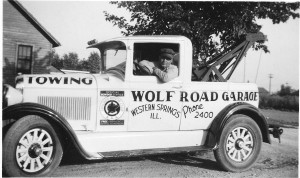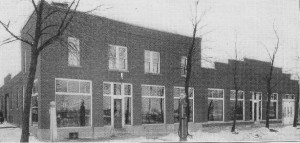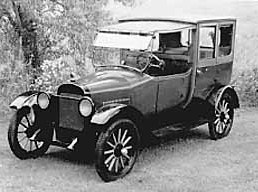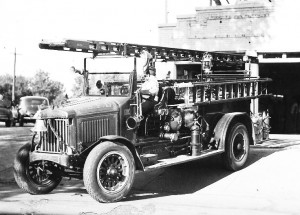In 1920, Western Springs was home to just 1,258 residents and 100 automobiles. But, who could someone call for a tow or flat tire?

Wolf Road Garage’s Tow Truck – circa 1930
In 1920, Wolf Road in Western Springs was just an unpaved dirt street. The most common vehicles were still horse-drawn wagons and buggies. But, Fred Tiedt and Fred Hahn could see the future of the automobile. So, in March of that year, they announced plans to build the “Wolf Road Garage” for handling “repair work of all kinds”.
They first purchased three lots on the northeast corner of Wolf and Hillgrove, where they constructed a garage shown on the right, 113 feet by 50 feet in size.

Wolf Road Garage – right
Shortly after opening the new garage, the owners announced they would also be selling new automobiles. And, in 1923, as business expanded, they added the auto showroom on the left. Note the gasoline pump on the curb.
The new owners decided to offer Maxwells (see photo), as well as Chalmers, and Franklin automobiles. And, to build up their auto inventory quickly, they hired several local men to travel with them to Detroit where they purchased new Maxwells and Chalmers cars direct from the factories. They then drove them back to Western Springs. That’s the way it was done in 1920.

1920 Maxwell Town Car
Unfortunately, those models didn’t survive very long in the marketplace. So, by 1924, the dealership had shifted over to selling the then-popular Studebaker line… 154 cars in just that one year alone. In addition, the dealership sold and installed Atwater-Kent car radios, a brand new option for auto enthusiasts. The company also offered International trucks for sale. In fact, in 1924, they handled the delivery of Western Springs’ first fire engine.
As auto sales became a bigger part of the business, the company’s name was changed to “Wolf Road Auto Sales”. In 1928, the business was purchased by the Glasner Brothers, who continued to expand the Studebaker franchise. However, in 1932, the business was sold back to the original owners. And, in 1934, the agency became an exclusive Ford dealership.

Western Springs’ first fire engine – 1924
Eventually, the nation’s Great Depression, as well as increased competition, spelled the end for both the garage and auto dealership. But, what became of the buildings?
First, the corner showroom was demolished to make way for a gasoline station. Later, the original garage became a retail store, The Ship’s Wheel, as described in our story last week. And, in 1967, a new Village Hall was built on the two sites, thus erasing the last traces of the Wolf Street Garage.
